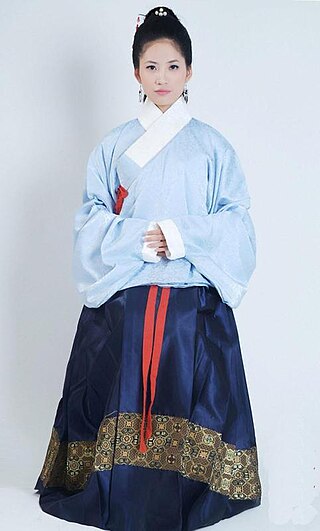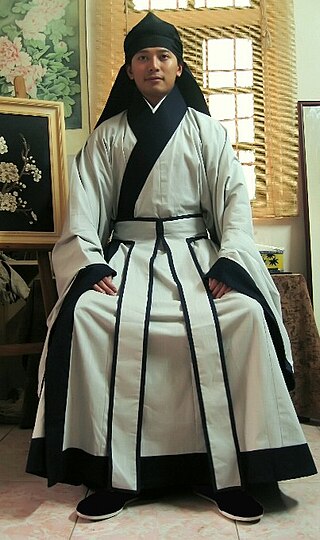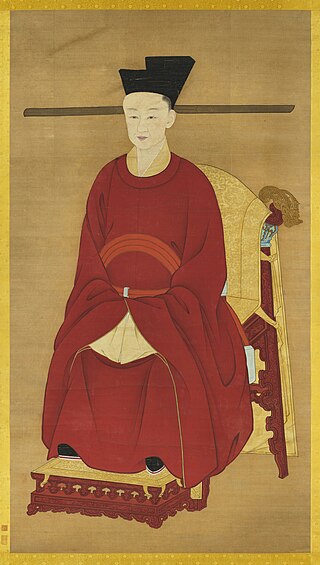
Cheongsam or zansae, also known as the qipao and sometimes referred to as the mandarin gown, is a Chinese dress worn by women which takes inspiration from the qizhuang, the ethnic clothing of the Manchu people. The cheongsam is most often seen as a longer, figure-fitting, one piece garment with a standing collar, an asymmetric, left-over-right opening and two side slits, and embellished with Chinese frog fasteners on the lapel and the collar. It was developed in the 1920s and evolved in shapes and design over years. It was popular in China from the 1920s to 1940s, overlapping with the Republican era, and was popularized by Chinese socialites and high society women in Shanghai. Although the cheongsam is sometimes seen as traditional Chinese clothing, the cheongsam continues to evolve with times as it responds to the contemporary modern life.

Vietnamese clothing or Việt phục (越服) is the traditional style of clothing worn in Vietnam by the Vietnamese people. The traditional style has both indigenous and foreign elements due to the diverse cultural exchanges during the history of Vietnam. Due to it being part of the Sinosphere, Vietnamese traditional clothing have elements which bear similarities to those of China, Korea, and Japan. This all eventually led to the birth of a distinctive Vietnamese style of clothing, including the birth of the modern national dress of Vietnam, the áo dài.
Hanfu Movement, also known as the Hanfu Revival Movement, is a cultural movement seeking to revitalize Han Chinese fashion that developed in China since 2003.

Gwanbok is a Korean term which was borrowed from the Chinese terms guanfu and guanfu. The term gwanbok is a collective term which refers to historical official attire, which was bestowed by the government court, including Chinese courts of various dynasties. The guanfu (冠服) system was a court attire system in China which also formed part of the Hanfu system. This system was them spread to neighbouring countries and was adopted in Korea since ancient times in different periods through the ritual practice of bestowal of clothing. Acknowledgement through bestowed robes and crowns (冠服) from the Emperor of China, who held hegemony over East Asia, would give support to Korean Kings and successors, as being the authentic rulers of their country as well as confirmed the political status of the Korean kingdom in the rest of the Sinosphere. The gwanbok system in Korea was different for each kingdom and changed throughout different periods. For example, initially given by the Chinese court in ritual practice, successive gwanbok were more often than not locally manufactured in Korea with different colours and adopted into hanbok. The gwanbok, which was used as the uniform of court officials, formed part of the gwanbok system and was used like the suit is nowadays.

Ruqun is a set of attire in Hanfu which consists of a short jacket typically called ru worn under a long Chinese skirt called qun. However, when use as a general term, ruqun can broadly describe a set of attire which consists of a separated upper garment and a wrap-around lower skirt, or yichang, in which yi means the "upper garment" and the chang means the "lower garment". In a broad sense, ruqun can include the shanqun and aoqun in its definition.
Banbi, also known as banxiu and sometimes referred as beizi or half-beizi before the term beizi eventually came to refer to a long-sleeved beizi in the Song dynasty, and referred as dahu in the Yuan dynasty, is an upper garment item in Hanfu. The banbi is in the form of a waistcoat or outerwear with short sleeves, which could either be worn over or under a long-sleeved ruqun. The style of its collar varies; it can also be secured at the front either with ties or a metal button.
A yuanlingshan is a type of round-collared upper garment in the traditional Chinese style of clothing known as Hanfu; it is also referred to as a yuanlingpao or a panlingpao when used as a robe. The yuanlingshan and yuanlingpao were both developed under the influence of ancient Chinese clothing, known as Hufu, originating from the Donghu people during the early Han dynasty and later by the Wuhu, including the Xianbei people, during the Six Dynasties period. The yuanlingpao is an article of formal attire primarily worn by men, although in certain dynasties, such as the Tang dynasty, it was also fashionable for women to wear. In the Tang dynasty, the yuanlingpao could be transformed into the fanlingpao using buttons.
Panling lanshan (盤領襴衫), also referred as lanshan (襴衫), is a traditional Chinese attire for men. It is a specific form of round collar robe, known as yuanlingpao, which is characterized with the use of hem, called hanglan (横襕), also referred as lan (襕)). The panling lanshan was a new type of garment, developed in the Northern and Southern dynasties through the localization of the round-collar garments which had been introduced by the ethnic minorities, such as the Xianbei. Panling lanshan continued to be worn in the Tang Dynasty. The panling lanshan along with the futou was used as the Tang dynasty attire of scholars and officials. The scholars' attire in the succeeding dynasties followed the style of the panling lanshan of the Tang dynasty. It is also a formal attire worn by scholars and students (生員) taking the imperial examination in Ming Dynasty.

Shenyi, also called Deep garment in English, means "wrapping the body deep within the clothes" or "to wrap the body deep within cloth". The shenyi is an iconic form of robe in Hanfu, which was recorded in Liji and advocated in Zhu Xi's Zhuzi jiali《朱子家禮》. As cited in the Liji, the shenyi is a long robe which is created when the "upper half is connected to the bottom half to cover the body fully". The shenyi, along with its components, existed prior to the Zhou dynasty and appeared at least since the Shang dynasty. The shenyi was then developed in Zhou dynasty with a complete system of attire, being shaped by the Zhou dynasty's strict hierarchical system in terms of social levels, gender, age, and situation and was used as a basic form of clothing. The shenyi then became the mainstream clothing choice during the Qin and Han dynasties. By the Han dynasty, the shenyi had evolved into two types of robes: the qujupao and the zhijupao. The shenyi later gradually declined in popularity around the Wei, Jin, and Northern and Southern dynasties period. However, the shenyi's influence persisted in the following dynasties. The shenyi then became a form of formal wear for scholar-officials in the Song and Ming dynasties. Chinese scholars also recorded and defined the meaning of shenyi since the ancient times, such as Zhu Xi in the Song dynasty, Huang Zongxi in the Ming dynasty, and Jiang Yong in the Qing dynasty.
Dragon robes, also known as gunlongpao or longpao for short, is a form of everyday clothing which had a Chinese dragon, called long (龍), as the main decoration; it was worn by the emperors of China. Dragon robes were also adopted by the rulers of neighbouring countries, such as Korea, Vietnam, and the Ryukyu Kingdom.

Hanfu are the traditional styles of clothing worn by the Han Chinese. There are several representative styles of hanfu, such as the ruqun, the aoqun, the beizi and the shenyi, and the shanku.

The Round collar robe, also called yuanlingpao and yuanlingshan in China, danryeong in Korea, was a style of paofu, a Chinese robe, worn in ancient China, which was long enough to cover the entire body of its wearer. The Chinese yuanlingpao was developed under the influences of the Hufu worn by the Donghu people and by the Wuhu. Depending on time period, the Chinese yuanlingpao also had some traces of influences from the Hufu worn by the Sogdian. The Chinese yuanlingpao continued to evolve, developing distinctive Chinese characteristics with time and lost its Hufu connotation. It eventually became fully integrated in the Hanfu system for the imperial and court dress attire. Under the influence of ancient China, the Chinese yuanlingpao was adopted by the rest of the East Asian cultural sphere.

The official court dress of the Empire of Japan, used from the Meiji period until the end of the Second World War, consisted of European-inspired clothing of the 1870's. It was first introduced at the beginning of the Meiji period and maintained through the institution of the constitutional monarchy by the Meiji Constitution, and represented the highest uniforms in use at the time. Uniforms for members of the kazoku peerage and civil officials were officially set.

Zaju chuishao fu, also called Guiyi, and sometimes referred as "Swallow-tailed Hems and Flying Ribbons clothing" or "swallow tail" clothing for short in English, is a form of set of attire in hanfu which was worn by Chinese women. The zaju chuishao fu can be traced back to the pre-Han period and appears to have originated the sandi of the Zhou dynasty; it then became popular during the Han, Cao Wei, Jin and Northern and Southern dynasties. It was a common form of aristocratic costumes in the Han and Wei dynasties and was also a style of formal attire for elite women. The zaju chuishao fu can be further divided into two categories of clothing style based on its cut and construction: the guipao, and the guichang.

Paofu, also known as pao for short, is a form of a long, one-piece robe in Hanfu, which is characterized by the natural integration of the upper and lower part of the robe which is cut from a single fabric. The term is often used to refer to the jiaolingpao and the yuanlingpao. The jiaolingpao was worn since the Zhou dynasty and became prominent in the Han dynasty. The jiaolingpao was a unisex, one-piece robe; while it was worn mainly by men, women could also wear it. It initially looked similar to the ancient shenyi; however, these two robes are structurally different from each other. With time, the ancient shenyi disappeared while the paofu evolved gaining different features in each succeeding dynasties; the paofu continues to be worn even in present day. The term paofu refers to the "long robe" worn by ancient Chinese, and can include several form of Chinese robes of various origins and cuts, including Changshan,Qipao, Shenyi,Tieli, Zhisun, Yesa.

After the fall of the Tang dynasty, the Khitans, a branch of the Eastern Xianbei tribes, established Liao dynasty in northern China. The Liao dynasty comprised two regions: the Northern and Southern Divisions. The Northern divisions of Liao was mainly composed of tribal Khitan people while the Southern regions was composed of the Han and other sedentary groups. The rulers of the Liao dynasty adopted a clothing system which allowed the coexistence of Han and Khitan clothing.

Hufu, also referred as Hu clothing, nomadic dress, 'barbarian' clothing or dress, or foreign dress, is a generic term which refers to any clothing which was worn in ancient China and its surrounding regions by non-Han Chinese people. This term is also used to refer to foreigner's dress or clothing of foreign origins in ancient China. The introduction of Hufu-style garments and attire in China occurred by the time of King Wuling of Zhao.

Garment collars in hanfu are diverse and come in several shapes, including jiaoling, duijin, yuanling, liling, fangling, tanling. Some forms of collars were indigenous to China while others had been adopted from the Hufu of other non-Han Chinese ethnic minorities and/or from the clothing worn by foreigners.

Fanlingpao, sometimes referred to as kuapao and hufu in the Tang dynasty when they feature double overturned lapels, is a type of paofu with lapels. It was categorized as Hufu instead of Hanfu due to its association with clothing of the foreigners who came from the Silk road. Fanlingpao were first introduced in China during the Northern Wei dynasty and became popular in Northern Qi. The custom of wearing fanlingpao were then inherited and further developed in the Sui and Tang dynasties. The fanlingpao could be transformed into a round collar robe, called yuanlingpao, in the Tang dynasty through the use of buttons. The fanlingpao shows foreign influences, which are mostly likely from the Persian, Sassanian Persian, Iranian Sogdian, and Turkic. Fanlingpao were popular fashion during Tang dynasty for both men and women and showed the popularity of Hufu-style clothing during this period; it was considered hufu while yuanlingpao was categorized as a form Hanfu.
Guan, literally translated as hat or cap or crown in English, is a general term which refers to a type of headwear in Hanfu which covers a small area of the upper part of the head instead of the entire head. The guan was typically a formal form of headwear which was worn together with its corresponding court dress attire. There were sumptuary laws which regulated the wearing of guan; however, these laws were not fixed; and thus, they would differ from dynasty to dynasty. There were various forms and types of guan.

















